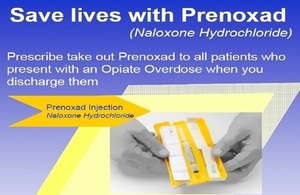Working with accident and emergency units to distribute naloxone
Patients who presented to A&E with a heroin overdose In Brighton and Hove are supplied with naloxone when they are discharged.

Summary
Heroin users who are not in treatment are at greater risk of death. Access to and use of naloxone – the ‘antidote’ to heroin overdose – has had proven effect in reducing mortality. We identified heroin users who were presenting to A&E following an overdose, and decided to use this opportunity as a way of increasing access to naloxone to those who may not have been able to access it through other means.
A clinical audit showed 38 individuals presented with an opiate overdose to A&E in a 10-month period. Only 6 were in contact with the local drug service, so had little opportunity to receive naloxone or associated first aid training.
A scheme was therefore developed to enable the A&E clinical team to give out naloxone to patients presenting with a heroin overdose, on their discharge from hospital.
The beneficiaries of this intervention are heroin users who:
- are not known to treatment services
- have disengaged from treatment
- are in treatment, using heroin on top of their prescription and may not have disclosed this to their keyworker
Case study
Brighton and Hove has historically had one of the highest rates of drug-related deaths (DRD) in England and Wales. We introduced a naloxone distribution programme in 2010 and have since then looked at novel ways to increase access to naloxone for those at risk of overdose.
Brighton and Hove public health team, SMS Pavilions (the local drug treatment service), A&E consultant staff, the wider medical and nursing team in A&E and the hospital pharmacy have all worked together to consider how naloxone provision can be extended to those not in contact with other services.
What was involved
We used clinical audit to identify the need for naloxone distribution via A&E by identifying a group of heroin users who were not actively engaged in treatment.
Between 1 January and 24 October 2012, 38 individuals presented to A&E with an opiate overdose. When the details of these clients were compared with those of the Substance Misuse Service (SMS) it was evident that at the time of their overdose only 6 were in active contact with the service. This meant that they were less likely to have had the opportunity to receive naloxone or the associated first aid training. We used this information to work with our colleagues in the A&E clinical team to enable them to give out naloxone to patients presenting with a heroin overdose, on their discharge from hospital.
We worked with the A&E team, including pharmacy staff, to add naloxone to the hospital formulary. The substance misuse nursing staff based in A&E work to reinforce the distribution of naloxone on discharge to this patient group.
On 6 March 2013, Brighton’s local paper Brighton Argus said:
One reason for the fall in deaths has been the rollout of naloxone – an emergency antidote to heroin.
We are continuing to support good practice within the A&E team by promoting the use of naloxone through education sessions, and completing regular audits of the distribution of naloxone to patients discharged following a heroin overdose.
What works well
We found that the partnership between the SMS, public health and acute hospital trust helped the scheme to be effective. Seeing the positive effect on our rate of DRDs also helped bolster continuing support for the scheme.
What could be better
We have more work to do to continue to maintain and embed good practice.
Next steps
Liz Tucker, Public Health Practitioner at Brighton and Hove City Council, said:
We want to maintain good practice locally and share our learning with other areas across the country.
Further information
Please contact: Liz Tucker, Public Health Practitioner, Brighton and Hove City Council.